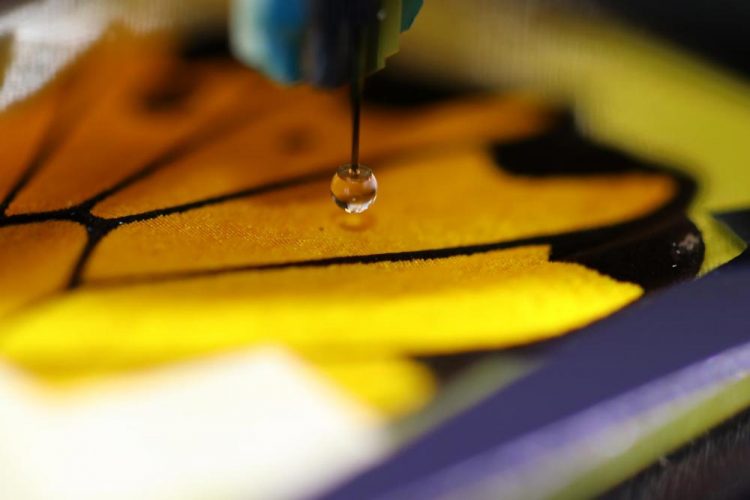New microscope sets a record for visualizing surface wetting properties

The droplet probe of the microscope on a superhydrophobic golden birdwing (Troides aeacus) butterfly wing. Credit: Matti Hokkanen / Aalto University
Wetting is an everyday phenomenon that represents how well liquid spreads on a surface. When water comes into contact with an extremely water-repellent, or 'superhydrophobic' surface, droplets bead up and roll off easily. Aalto University researchers have developed a measurement technique called Scanning Droplet Adhesion Microscopy (SDAM) to understand and characterize the wetting properties of superhydrophobic materials.
“Our novel microscope will promote the understanding of how wetting emerges from surface microstructures. The measuring instrument can also detect microscopic defects of the surface, which could allow coating manufacturers to control the quality of materials.
Defects in self-cleaning, anti-icing, anti-fogging, anti-corrosion or anti-biofouling products can impeach the functional integrity of the whole surface,” explains Professor Robin Ras from Aalto University School of Science.
SDAM is extremely sensitive and 1000 times more precise than the current state-of-the-art wetting characterization methods. It also has the ability to measure minuscule features and inconsistencies of surfaces with microscale resolution. Existing instruments for measuring droplet adhesion forces only detect forces down to a micronewton level – not sensitive enough for superhydrophobic surfaces.
“We have used a droplet of water to measure the water-repellent properties of a surface by recording the very tiny nanonewton force when the droplet touches the surface and when it separates from the surface. By measuring on many locations with micrometer spacing between the measurement points, we can construct a two-dimensional image of the surface's repellency, called a wetting map,” explains Professor Quan Zhou from Aalto University School of Electrical Engineering.
Wetting maps are a new concept for hydrophobic surface characterization and open a window for investigating structure-property relationships in surface wetting.
Up to now, 'contact angle measurement' has been the typical method of measuring wetting properties of surfaces. It is prone to inaccuracies, though, for surfaces that are highly repellent to liquid. Unlike contact angle measurement, SDAM does not require a direct line of sight, which allows measuring uneven surfaces such as fabrics or biological surfaces. SDAM can also detect wetting properties of microscopic functional features that were previously very hard to measure. Those microscopic features are important in many biochips, chemical sensors and microelectromechanical components and systems.
###
The research is conducted by an interdisciplinary team from three schools of Aalto University: School of Electrical Engineering, School of Science, and School of Chemical Technology. The researchers involved in the study are Ville Liimatainen, Maja Vuckovac, Ville Jokinen, Veikko Sariola, Matti Hokkanen, Quan Zhou and Robin Ras.
More information:
The article “Mapping microscale wetting variations on biological and synthetic water-repellent surfaces” has been published today in Nature Communications.
Liimatainen V., Vuckovac M., Jokinen V., Sariola V., Hokkanen M., Zhou Q., Ras R.H.A., Mapping microscale wetting variations on biological and synthetic water-repellent surfaces, Nature Communications (2017) 1798. http://dx.
Robin Ras
Professor
Aalto University
Department of Applied Physics & Department of Bioproducts and Biosystems
robin.ras@aalto.fi
tel. +358 50 432 6633
http://physics.
Quan Zhou
Professor
Aalto University
Department of Electrical Engineering and Automation
quan.zhou@aalto.fi
tel. +358 40 855 0311
http://eea.
Media Contact
All latest news from the category: Materials Sciences
Materials management deals with the research, development, manufacturing and processing of raw and industrial materials. Key aspects here are biological and medical issues, which play an increasingly important role in this field.
innovations-report offers in-depth articles related to the development and application of materials and the structure and properties of new materials.
Newest articles

High-energy-density aqueous battery based on halogen multi-electron transfer
Traditional non-aqueous lithium-ion batteries have a high energy density, but their safety is compromised due to the flammable organic electrolytes they utilize. Aqueous batteries use water as the solvent for…

First-ever combined heart pump and pig kidney transplant
…gives new hope to patient with terminal illness. Surgeons at NYU Langone Health performed the first-ever combined mechanical heart pump and gene-edited pig kidney transplant surgery in a 54-year-old woman…

Biophysics: Testing how well biomarkers work
LMU researchers have developed a method to determine how reliably target proteins can be labeled using super-resolution fluorescence microscopy. Modern microscopy techniques make it possible to examine the inner workings…





















